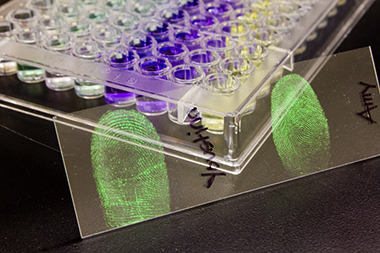Chemist’s Technique Can Identify a Fingerprint as Male or Female
 |
|
A team of researchers led by UAlbany chemistry professor Jan Halámek have discovered a straightforward concept for identifying whether a culprit is male or female. It’s based on amino acid levels in fingerprints. (Photo by Paul Miller)
|
ALBANY, N.Y. (November 30, 2015) -- Culprits beware, a University at Albany research group, led by assistant chemistry professor Jan Halámek, is taking crime scene fingerprint identification to a new level.
Halámek and his team of researchers at UAlbany have discovered a straightforward concept for identifying whether a culprit is male or female. It’s based on the content in fingerprints – specifically amino acids.
According to known literature, amino acid levels in the sweat of females are about twice as high as in males. There’s also a slightly different distribution, due mostly to hormonal differences. The same is true for amino acids left behind in fingerprints. Halámek’s research team has devised a simple method to back up these claims.
As a starting point, Halámek’s team extracts amino acids from a fingerprint by transferring it onto a piece of plastic wrap. A hydrochloric acid solution is then placed onto the fingerprint, followed by heating. This process allows for the water-soluble amino acids to migrate into the acidic solution. From there, the team can easily view amino acid levels, distinguishing sex.
Halámek and his colleagues first tested this method on “mimicked fingerprint samples,” which they found to have a 99 percent accuracy of correct sex classification. From there, they set up a real crime scene scenario. Three female volunteers placed their fingerprints on five different surfaces, including a doorknob and a computer screen. Regardless of the surface type, Halámek’s team found it was possible to tell the fingerprint belonged to a woman.
“One of the main goals for this project was to move toward looking at the chemical content within the fingerprint, as opposed to relying on simply the fingerprint image,” Halámek said. “We do not intend to compete with DNA analysis or the databases used for identification.
According to Halámek, this is only the beginning of his research. He’s currently in the process of developing additional identification methods for other forensically-relevant attributes, as well as improving on the current fingerprint concept.
Halámek’s full study is published in Analytical Chemistry. It has been featured in the New York Times, as well as various other publications, including Chemical & Engineering News, Science Alert and Forensics Magazine.
![]() For more news, subscribe to UAlbany's RSS headline feeds
For more news, subscribe to UAlbany's RSS headline feeds
A comprehensive public research university, the University at Albany-SUNY offers more than 120 undergraduate majors and minors and 125 master's, doctoral and graduate certificate programs. UAlbany is a leader among all New York State colleges and universities in such diverse fields as atmospheric and environmental sciences, business, education, public health,health sciences, criminal justice, emergency preparedness, engineering and applied sciences, informatics, public administration, social welfare and sociology, taught by an extensive roster of faculty experts. It also offers expanded academic and research opportunities for students through an affiliation with Albany Law School. With a curriculum enhanced by 600 study-abroad opportunities, UAlbany launches great careers.


